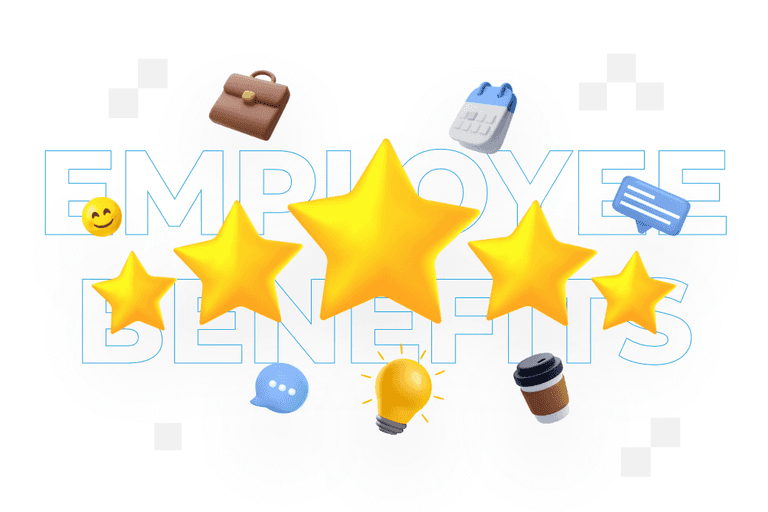
Employee benefits – ideas and examples

Discovering the power of employee benefits, companies are outdoing themselves in creativity to offer more than just compensation. How do these additional benefits translate into success for both employees and the organisation as a whole?
In this article you will find out:
- What are employee benefits?
- What are the types of employee benefits?
- How do employee benefits affect the working atmosphere?
- How do you choose employee benefits?
- What are examples of employee benefits?
- How do you measure the effectiveness of employee benefits?
- What can you gain from employee benefits?
Employee benefits – definition
Employee benefits are a broadly defined category of additional benefits offered to employees by employers that complement standard remuneration for work. Their essence is to provide added value to the employment package, which is often aimed at increasing employee satisfaction and loyalty, as well as making the employer more attractive in the labour market.
Employee benefits are characterised by a variety of forms and delivery methods, and can include both tangible and intangible elements. They not only provide additional financial support, but also contribute to improving employees’ quality of life, health, personal development or work-life balance.
An employee benefit is an additional benefit offered by the employer over and above remuneration, with the aim of increasing employee satisfaction and loyalty.
Definition of employee benefits
A defining element of employee benefits is that they are voluntary – they do not derive directly from employment law, but are offered by employers as part of a people management strategy. Although they are not mandatory, in practice they have become an informal standard, especially in companies seeking to attract and retain qualified employees. They are also a form of investment in the team, as increased employee satisfaction can translate into increased productivity and engagement.
Types of employee benefits
Employee benefits can be classified into different categories, depending on their nature, the way they are provided and the objectives they are intended to fulfil. Each category responds to the different needs of employees and can be adapted to the specific characteristics of the company, the industry and the financial capacity of the employer. Benefits can have a motivational function and serve to build a positive corporate image as a responsible and attractive employer. Here are the most common types of benefits:
- Financial benefits are all forms of support of an economic nature that have a direct impact on the employee’s income.
- Health-related benefits refer to the provision of health care coverage to employees outside the standard health insurance system.
- Work and working time benefits refer to flexible forms of employment, the possibility to work remotely, flexible working hours or longer holidays.
- Development benefits are a category covering professional and personal development opportunities, including training, courses, postgraduate studies and other forms of competence development support.
- Social benefits are benefits that support employees and their families in various life situations, e.g. assistance programmes, social funds, crisis support.
- Work-life balance benefits focus on services that allow employees to balance work and private life.
- Leisure benefits support employees’ physical activity and recreation.
- Communication benefits include benefits related to commuting and transport, such as commuting reimbursement, public transport cards or company transport.
Employee benefits and working atmosphere
Employee benefits influence employees’ perceptions of their employer and their daily work experience. With additional benefits, employers signal that they care about employee wellbeing. When employees receive support above and beyond their basic salary, they feel valued and respected, which translates into greater engagement at work, better cooperation between colleagues, and a greater willingness to contribute positively to the organisational culture in a company.
For example, benefits, such as flexible working hours or the possibility to work remotely, allow employees to better align their work responsibilities with their personal lives, which can contribute to reduced levels of stress and burnout. On the other hand, a social benefit that can help an employee in a difficult life situation shows that the company stands not only as an employer, but also as a partner in daily challenges, which can build a strong sense of community among employees.
All the aspects mentioned above form a composition in which an employee benefit is no longer just a salary supplement, but a key element of the organisational culture that directly influences how employees feel at work, cooperate with each other and perceive their employer.
Choosing employee benefits
When selecting and planning employee benefits, it is crucial to understand the needs and expectations of employees and the specifics of the company. The employer should analyse the profile of their workforce, taking into account factors such as age, interests, social status and the type of work they do, in order to tailor a benefits package to their individual needs. It is also worth considering that employee benefits are an investment, so they should support and take into account the strategic objectives of the organisation.
Planning an effective employee benefits package requires consideration of the company’s budget. The costs associated with offering additional benefits need to be balanced against the expected value they bring – both to employees and to the company. It is worth thinking about which benefits bring the most value at the lowest cost and how they can be implemented most effectively. It is also important to bear in mind the legal aspects – some benefits may be regulated and require appropriate documentation or reporting. In addition, employees should be provided with clear information about benefits and the rules for awarding and using them.
When planning benefits, it is a good idea to remain flexible in order to adapt the benefits package in the future to changing market conditions, employee needs and company capabilities. It is important that benefits are not seen as a substitute for fair remuneration and the company should avoid them becoming a source of injustice – they should be available to all and any differences in the benefits package must be justified and transparent.
Examples of employee benefits
There are as many examples of employee benefits as there are companies implementing them. While some benefits (e.g. insurance or MultiSport cards) are standard for most organisations, there is no denying that some companies offer many more. Here are examples:
- Health insurance.
- Life insurance.
- Pension fund.
- Flexible working hours.
- Possibility to work remotely.
- Subsidised holidays (e.g. through a social fund).
- MultiSport card (access to various sports facilities).
- Food vouchers (e.g. shopping cards).
- Kindergarten or crèche for employees’ children.
- Private medical care.
- Subsidised courses and training.
- Postgraduate or MBA studies.
- Days off for educational purposes.
- Mentoring programmes.
- Subsidised transport (e.g. monthly tickets).
- Company car or fuel subsidies.
- Parking for employees.
- Wellness and spa packages.
- Psychological support programmes.
- Subsidised care for seniors or disabled family members.
- Relaxation or games room in the office.
- Team-building trips and company events.
- Annual or quarterly bonuses.
- Loyalty programmes and rewards for long-term service.
- Subsidised sports or cultural activities.
- Discounts on company products or services.
- Partnership programmes with other companies offering discounts to employees.
- Subsidised mobile phone or internet at home.
- Loans to employees on preferential terms.
- Support in career planning and development of professional skills.
Measuring the effectiveness of employee benefits
Measuring the effectiveness of employee benefits should be an integral part of your people management strategy. It starts by identifying the objectives that the company wants to achieve by offering specific benefits – these may include improving employee satisfaction, reducing turnover or increasing loyalty.
Both quantitative and qualitative indicators are used to assess the effectiveness of employee benefits. Data on the frequency of use of specific benefits can be analysed, as well as indicators related to attendance and absenteeism, which can signal employee satisfaction levels. Measurement can also include an analysis of the costs associated with maintaining a benefits package versus the benefits, such as reduced recruitment costs due to higher employee retention.
It is important to conduct regular employee satisfaction surveys to understand how they rate the benefits offered. They can be asked how they perceive the added value of a benefit, whether it really affects their daily life and their decision to stay with the company. In turn, the interpretation of the results should take into account not only the raw data, but also the business and social context – if a company notices that, despite offering an extensive package of health benefits, employee turnover is still high, it is worth considering whether the problems lie in other areas, such as organisational culture or relations with superiors.
Benefits of employee benefits
From an employee perspective, additional benefits increase overall job satisfaction, help achieve a better work-life balance and translate into improved health and well-being. For employees who value continuous development, educational or training benefits can be an important motivational factor and help with career development.
For employers, a well-thought-out benefits package can be a tool to attract new talent, especially in highly competitive industries. In addition, benefits can act as a retention tool – employees who feel valued through additional benefits often show greater loyalty to their employer.
Companies that offer attractive benefit packages can be perceived as more socially responsible, which can improve their image both in the eyes of their employees and their customers, business partners or the local community. This can lead to the development of a strong employer brand.
FAQ
Contact form
Ensure the development of your business
Rate content:
You may be interested in:




